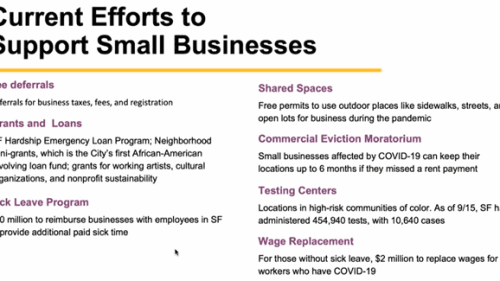Insights into working with tenants and lenders to weather the coronavirus crisis were shared by a diverse group of real estate professionals—a niche developer and investor specializing in space for life science companies, a mixed-use developer focused primarily on downtown revitalization and development, an affordable housing developer, and a real estate debt and equity adviser—during an April 14 webinar hosted by ULI’s Center for Capital Markets and Real Estate.
“Economics of COVID-19: How ‘Main Street’ Owners Are Navigating the Crisis with Their Tenants,” which was oriented toward small-scale, entrepreneurial developers, was the fourth in a series of webinars offered by ULI to explore how the real estate industry is being affected by the virus and the industry’s response.
The webinar is available for members to access at ULI’s Knowledge Finder.
Moderated by Howard Kozloff, managing partner at Agora Partners and partner at HATCHspaces in Los Angeles, the webinar featured Allan Glass, partner at HATCHspaces and president and chief executive officer of ASG Real Estate in Los Angeles; Cathy Sloss Jones, president of Sloss Real Estate in Birmingham, Alabama, and chair of ULI Alabama; Christopher Van Arsdale, managing partner at Heleos in Washington, D.C.; and Zachary Streit, senior vice president at George Smith Partners Inc. in Los Angeles.
While all the panelists addressed the impact of the pandemic on their business operations, their common message was this: During this time of unprecedented uncertainty, it serves small-scale developers and property owners well to communicate frequently and clearly with tenants and lenders, positioning themselves as solution providers for problematic rental and loan agreements.
Glass provided an overview of HATCHspaces’ experiences with essential and nonessential businesses during the virus outbreak. Because HATCHspaces develops and operates life science facilities for biotechnology firms, most of its tenants are an essential part of the workforce, so the buildings that house them have been deemed essential and have stayed open and occupied throughout the crisis.
“[Life sciences] is a very resilient sector, especially in situations like this,” he said.
The company’s adjustment to the virus crisis has been relatively smooth, because the life science tenants are accustomed to higher cleanliness standards and wearing protective gear such as face masks as part of their daily work routines, he explained.
“For our essential buildings with essential tenants, we’ve been making sure we have stricter cleaning and access procedures for the common areas and building entry points,” Glass said. The company has implemented more regimented procedures for package deliveries to tenants and is relying heavily on relationships with providers of custodial and security services and sanitation products to ensure that the buildings remain safe and healthy places to work.
He added that going forward, it is likely that the elevated cleanliness standards that have long been in place at medical-related buildings could become common in all commercial buildings.
Glass noted that HATCHspaces is renegotiating lease terms, including rental payment deferrals, with nonessential tenants that have had to cease operations in its buildings. In these situations, it is important “to make sure you address this as a partner, not as a landlord that needs to make mortgage payments,” he advised. “If you approach tenants that way, you will have more success in managing the process of rent deferment.”
In this time of disruption, it is critical to convey to tenants, equity partners, and lenders that “you are aware of the situation and have some type of plan to address it proactively,” Glass said. Both smaller equity partners and institutional partners need to know that “you are working with tenants in terms of their ability to pay rents, and you need to manage expectations in your loan documents. A lack of communication is the worst thing that can happen.”
Van Arsdale discussed the impact of the virus on low- and moderate-income tenants in Heleos’s multifamily properties, which include tenants receiving assistance through the federal government’s Section 8 housing subsidy program. As yet, Section 8 rental payments have continued without disruption, helping to offset the inability of some program recipients to pay their portion of the rent owed, he said.
At present, the company’s larger concern is the number of moderate-income, market-rate tenants who have lost their jobs and are not receiving housing subsidies, Van Arsdale noted. “We are proactively reaching out to tenants about their job situations, and we are putting them in touch with resources [such as housing counseling, tenant advocacy groups, and social service organizations]. We are constantly brainstorming about how we can help, because this is going to be a tsunami for a lot of tenants.”
Van Arsdale noted that future projects have been largely put on hold, citing a lack of new originations coming from the Low-Income Housing Tax Credit program, a temporary suspension of tax credit–related acquisitions by some community development financial institutions, and tougher requirements for new multifamily debt funded by government-sponsored enterprises Fannie Mae and Freddie Mac.
“It feels like everyone has hit the pause button and is waiting until after the emergency is lifted to see what is left [to pursue],” he said. In the interim, the company is focused on reaching out to lenders and property managers to get as much data as possible to inform its short-term and longer-term operations, Van Arsdale added.
Jones explained that the local businesses in Sloss Real Estate’s main downtown development, Pepper Place, have been hit particularly hard by shutdowns due to the coronavirus. “The businesses that really bring the creativity and uniqueness to the neighborhood are mostly locally owned businesses, theaters, and restaurants. We are working with them, keeping communications open, to try to help them get through this,” she said.
Jones noted that a farmers market—a focal point of Pepper Place that has morphed into a weekend drive-through market—has been particularly helpful as a venue for restaurants and other food-related businesses serving take-out meals. In addition, a tenant communications committee has been formed to brainstorm with Sloss Real Estate “on how to come out of this as a community,” she said.
Sloss Real Estate began in the early stages of the virus to create a loan forbearance agreement that would be acceptable to the company’s lenders, as well as an asset management plan to determine which tenants would be able to continue paying rent and which would not.
“We wanted to be strategic about presenting a plan to our lenders,” Jones said. “We have a long-term relationship with our local banks, and they have been great to work with. We have not asked lenders for anything we felt we could carry on our own, and they seemed to appreciate that approach.”
According to Streit, small-scale developers may have some advantages in working with lenders, in that many of them tend to have relationships with local banks and other sources such as private lenders that may have flexible capital and may be more open to loan modifications such as deferred interest payments, deferred principal payments, or both.
The more complicated restructuring involves conduit loans that are managed by master servicers and special servicers rather than the loan originators, he said. While modifications of conduit loans can be time consuming and expensive, some examples of modifications include temporary debt service abatement, with the interest accrued being capitalized into the loan’s balance.
“The main recommendation I would make to a small-scale developer with respect to conduit loans is to engage a consultant who is a specialist in this, who knows the special servicers, and who knows the modifications that are achievable in this environment,” Streit said.
In general, both small and large lenders appear more willing to work with borrowers during the coronavirus crisis than they were during the Great Recession that began in 2008, he noted. “So far, the mind-set has been, ‘We’re all in this together, and we need to figure it out,’” Streit said, adding that he has heard anecdotes of major lenders reaching out to clients and offering loan payment solutions. “The big question is how long will this willingness to help will last,” he said.
Streit noted that federal regulators currently do not appear to be encouraging lenders to take aggressive action; rather, they are encouraging them to work with mortgagees and tenants, which is proving vital for those involved in the hard-hit hospitality and retail sectors.
One key factor, he said, was the recent revival and expansion of the Federal Reserve’s Term Asset-Backed Securities Loan Facility (TALF) to include purchases of non–federal agency commercial-backed mortgage securities and some other previously excluded financial instruments. TALF was created during the Great Recession as a funding facility to help lenders meet the credit needs of households and small businesses by supporting the issuance of asset-backed securities collateralized by loans of various types to consumers and businesses.
The recent TALF expansion is significant, Streit said, because of the liquidity it provides to the financial system. “When lenders approach modifications and forbearance, they are doing so against the backdrop of their understanding of the market psychology and their projections for market liquidity. For the Fed to take this action that directly affects mortgage market liquidity is huge,” he said.
Streit advised small-scale developers to be proactive in reaching out to lenders (preferably by phone or teleconference rather than email) and presenting them with a coherent plan that includes details such as all discussions with tenants, dates of business closures, and all attempts by tenants to receive financial assistance.
“You need to appear prepared, and those items are key to achieving the mutually beneficial and positive outcomes we are seeing now,” he said. If these plans are presented in good faith, with a goal of attempting to preserve the value of the asset, “so far we have seen everything net favorably,” Streit added.
Kozloff, the webinar moderator, noted that the observations from the webinar participants reflect the great extent to which small-scale developers and property owners are directly involved with tenants and lenders during normal times, a role that has become even more amplified with the disruption caused by the COVID-19 outbreak. “They are the ones dealing with operations issues, negotiating with tenants and lenders, finding creative solutions in the face of nonpaying, struggling tenants and vacant properties,” he said. The webinar served as a demonstration of the Institute’s “commitment to small-scale, entrepreneurial development,” Kozloff added.
The coronavirus webinar series is being provided by ULI’s Building Healthy Places Initiative, created in 2013 to leverage the power of the Institute’s global networks to shape projects and places in ways that improve the health of people and communities. The goal of the series is to help members understand the role they can play in helping to slow the spread of the disease, help them navigate the long- and short-term impacts of the crisis, and help them understand how they can play a role in minimizing adverse impacts on vulnerable people.
The next webinar in the series, “Confronting COVID-19: Everything You Need to Know about Healthy Buildings Q&A Session,” is scheduled for April 21 at 1:00 p.m. Eastern Daylight Time. The webinars are free of charge and open to ULI members and others.
For more information related to COVID-19 and real estate, visit COVID-19: Industry Insights.
TRISH RIGGS, former senior vice president of communications at ULI, is now a freelance writer based in Falls Church, Virginia.



